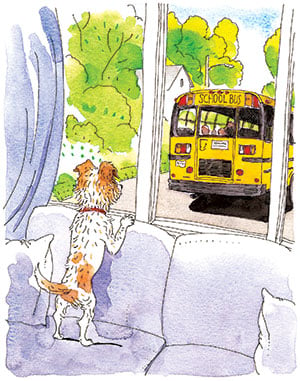
Between buying school supplies, signing up for extracurricular activities, and getting to know teachers, this time of year can be overwhelming for the whole family—including dogs.“Parents are so busy getting the kids ready for back to school that they don’t think about how the schedule is going to change dramatically for the dog,” says Washington dog trainer Kelly Spring.
Dogs love routine, so jumping from a laid-back summer into a packed fall can upset them. By September, many dogs have become more attached to the kids who for the past two or three months have stayed home to play with them. The same thing can happen with adult family members who are teachers and have the summer off. Dogs already prone to separation anxiety are most at risk, but even those that never previously displayed anxiety may start to exhibit symptoms. Says veterinary behaviorist Marsha Reich: “They get mopey and miss that interaction.”
Because the level of separation anxiety can vary depending on the dog, symptoms aren’t always obvious. “When it’s mild, most people don’t recognize it as a problem,” Spring says.
Some dogs have full-fledged panic attacks when their owners depart. They bark and howl all day or become destructive, tearing up furniture and even drywall. But subtler signs to look for include pacing, panting, and refusing to go into a crate or designated area when family members start to leave. Some dogs even follow their owners around and try to block them from the door.
Severely panicked dogs may require medication, and those that are destructive or refuse to eat should immediately visit a veterinarian. However, in other cases, you can try some simple fixes.
Reich, who makes house calls to clients throughout Washington, recommends food-dispensing toys, such as Kongs, which can be filled with treats to distract dogs while their owners depart and keep them occupied throughout the day. She suggests stuffing them with peanut butter or, for a lower-calorie option, unsweetened applesauce.
Another trick is to keep hellos and goodbyes low-key so you don’t encourage your dog to view them as dramatic and emotional.
Trainers often teach people exercises to help dogs relax. Gaithersburg vet Kathryn Meyer shows clients how to get dogs to calm themselves and remain in one place while their owners move toward the exit. Though it can take weeks or months to see improvement, Meyer says the work usually pays off.
Preventing separation anxiety in the first place, however, is the key for many dogs.
Meyer recommends easing them into a fall schedule up to a month before school starts by gradually leaving them alone for longer periods. That way, the first day of school won’t come as a shock.
People who plan to have neighbors or dog walkers visit their pet midday should allow them to get to know the animal in advance. Meyer has seen dogs traumatized because they didn’t have enough time to adjust to their caretakers. Rushing home at lunchtime yourself isn’t necessarily a better option, Reich says. Doing so could actually increase anxiety in some dogs. They’ll just have to endure getting left behind again when you return to work—and one goodbye is hard enough.
This article appears in the September 2013 issue of The Washingtonian.

















